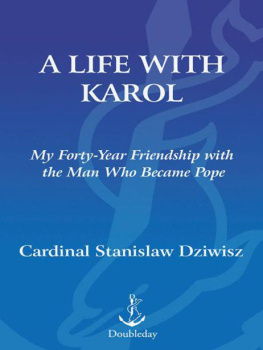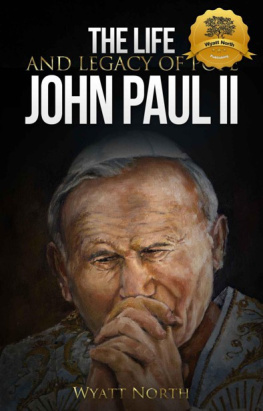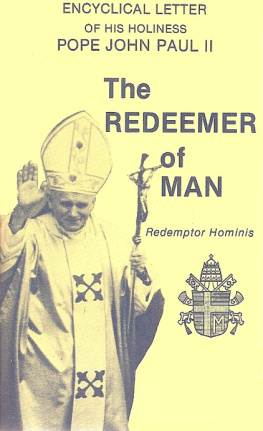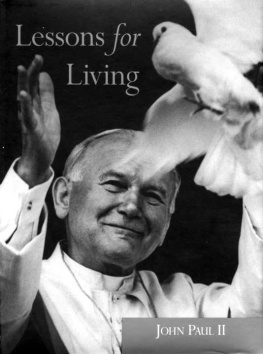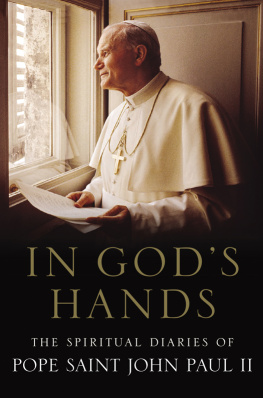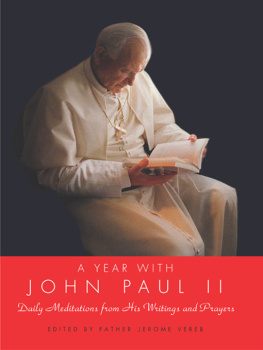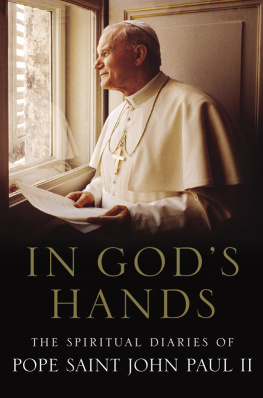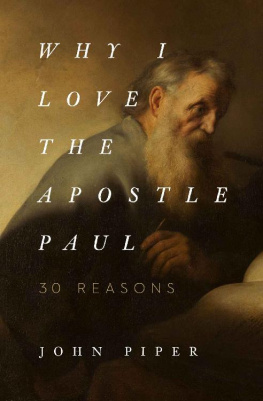
LET ME GO TO THE FATHER'S HOUSE
John Paul II's Strength in Weakness
Stanislaw Dziwisz
CzeslawDrazek, SJ
RenatoBuzzonetti
Angelo Comastri
Pauline Books & Media Boston, MA
CONTENTS
By Elio Guerriero
BY STANISLAW DZIWISZ AND CZESLAW DRAZEK, SJ
Strength in Weakness
The Pope of the Sick and the Suffering
At the Shrine of Pain and Hope
Toward the Father's House
Conclusion
By Renato Buzzonetti
By Angelo Comastri
The Unanimous and Immediate Acclaim of the People of God
Some Personal Recollections
Messages Left on the Pope's Tomb
The Last Note Left on the Tomb of John Paul II
Identifying Some of the Main Themes of John Paul II's Sanctity
FOREWORD
BETWEEN THE END OF MARCH and the first days of April 2005, a breathless world followed John Paul II's suffering and passage to the Father. That this was a time of grace was clear to the crowds that came from all over the world, surmounting all sorts of difficulties to be at St. Peter's Square and then at the tomb of John Paul, whom they regarded as a man of God and called upon as a saint.His suffering and tenacity were striking. Although the elderly pontiff could no longer speak, everyone understood that his death was the ultimate act of love offered to God on behalf of Christians, other believers, and all people. This book gives us the opportunity to relive that time of grace through the testimony of three eminent persons who were close to John Paul II for different reasons. The first part was written in collaboration by Father Czeslaw Drazek and His Eminence Cardinal Stanislaw Dziwisz, who for years was the pope's personal secretary, but above all his friend and confidant. This part recounts the Polish pope's great love for those who suffer, and the desire he showed from the first day of his pontificate to be close "to the sick, the poor, the suffering, the least fortunate." Karol Wojtyla was intimately familiar with suffering, having experienced it in his childhood and youth with the deaths of his mother, his brother, and his father.
Then came the dramatic years of Nazi war and persecution, followed by Soviet occupation and the dictatorship of the Communist party. All of these episodes made John Paul II "the pope of the sick and the suffering." On May 13, 1981, Ali Agca brought the pope, in Archbishop Dziwisz's words, "to the shrine of pain and suffering," where he had his most intense experience of closeness with those who suffer. The pontiff's Way of the Cross continued silently through the years until its consummation on April 2, 2005. And when he expressed his desire to go to the Father's house, it seemed natural to those standing nearby to sing, not the prayer for the deceased, but the Te Deum, the song of thanksgiving to God for the gift of the person of the Holy Father and his tremendous pontificate.
The testimony of his personal secretary is accompanied by that of Professor Renato Buzzonetti, the pope's personal physician since 1978. The doctor recalls the pope's many hospitalizations at the Gemelli, nicknamed "Vatican III," but also the attitude of profound interior serenity that led him to accept sickness, pain, and forced inactivity from the hand of God. This account also contains some previously unpublished details on the dramatic events of the assassination attempt and the pope's last days.At the end, His Excellency Archbishop Angelo Comastri, who manages St. Peter's Basilica, describes the emotionally charged devotion of those who defied all discomfort to come to Rome for one last farewell to this great pontiff. Such devotion shows no sign of decreasing, because "the procession of faithful and devout crowds continues past his humble tomb dug into the earth of the Vatican hillside." And this isn't superstition! These people know that John Paul II was entirely dedicated to the service of God and of Jesus Christ. By paying homage to the pope, they praise the Lord who gave him to the Church and to our age.ELIOGUERRIERO
SUFFERING IN THE LIFE AND TEACHING OF JOHN PAUL II
By
Stanislaw Dziwisz
Archbishop of Krakow
andCzeslaw Drazek, SJ
Editor of the Polish edition of L'Osservatore Romano
THE DAY AFTER HIS ELECTION to the See of Peter, John Paul II manifested his desire that the apostolic service he had accepted in a spirit of obedience to Christ should become, "from this very moment, a ministry of love in all its manifestations and expressions." This desire was continually realized before our eyes. One of the most characteristic features of the Holy Father's pastoral activity was his close connection with crowds, individuals, groups from various backgrounds, members of different religious faiths, and people from all walks of life. Among these, a privileged place was occupied by the sick, the poor, the suffering, the "least brethren" (Mt 25:40)all those deprived of their dignity and their fundamental rights.In the Holy Father's teaching, man is the first and primary way of the Church, but this is especially true of suffering man. The most perfect example of the respect due to man is Jesus Christ, who, loving all, embraces with his greatest love those people who are sad and suffering.This attitude of love shaped the pastoral style of John Paul II, a style described very well by Cardinal Joseph Ratzinger when, on October 16, 2003, in the name of the College of Cardinals, he presented Pope John Paul II with best wishes on the occasion of the twenty-fifth anniversary of his pontificate:Over these twenty-five years, you, as the Vicar of Jesus Christ in the apostolic succession, have tirelessly traveled the world, not only to bring beyond every geographical boundary the Gospel of the love of God, made flesh in Jesus Christ; you have also crossed the boundaries of the spirit, of those so often far from one another and opposed to each other, in order to bring the estranged together, make friends of those who are separated, and make room in the world for the peace of Christ (cf. Eph 2:17). You have addressed yourself to the young and the old, to the rich and the poor, to the powerful and the humble, and have always demonstratedfollowing the example of Jesus Christa special love for the poor and the defenseless, bringing to all a spark of the truth and love of God. You have proclaimed God's will fearlessly, even where it is opposed to what people think and want. Like the Apostle Paul, you can say you have never sought any honor from men, but have cared for your children like a mother. Like Paul, you also are enamored of mankind and have desired to make them partake not only of the Gospel, but of your very life (cf. 1 Thess 2:5-8). You have taken upon yourself criticism and injury, but have roused gratitude and love and brought down the walls of hatred and estrangement. Today, we are able to witness how you have placed yourself entirely at the service of the Gospel, permitting yourself to be consumed (2 Cor 12:15). In your life, the word "cross" is not merely a word. You have let yourself be wounded by the cross in soul and body. And like Paul, you also bore suffering in order to make up in your earthly life, for the Body of Christ that is the Church, what is still lacking in the sufferings of Christ (Col 1:24).
We would like to place a particular emphasis in these reflections on this dimension of the life and ministry of John Paul II, marked from the beginning by the stigma of suffering that he transformed into an instrument of apostolate.
Strength in Weakness
The cross accompanied John Paul II from the first years of his life. He was struck by the suffering that always leaves a deep and permanent mark on the human soul, because it comes from the premature loss of those dearest to one. At nine years of age Karol lost his mother; four years later his older brother, Edmund, passed away. Edmund was a doctor and died at the age of just twenty-six after catching scarlet fever from one of his patients. The young Karol's memory was deeply marked by the image of his father standing beside his son's casket, weeping and repeating the prayer, "Your will be done."
Next page

